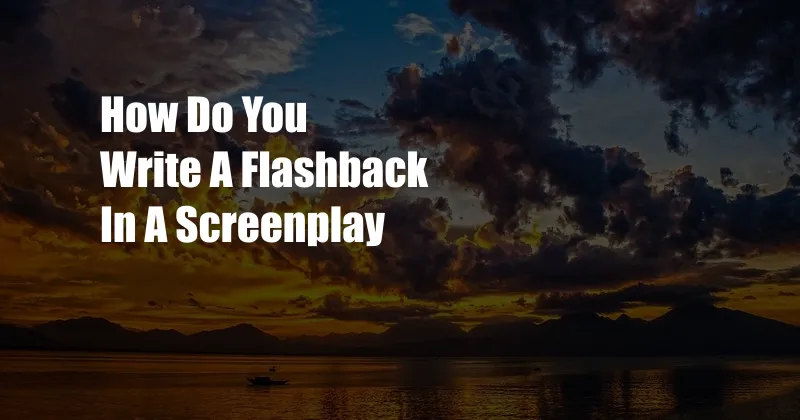
How to Write a Flashback in a Screenplay
The echoes of forgotten memories can haunt the corridors of our present. As writers, we have the power to delve into these recesses and bring them to life through the art of screenwriting. Flashbacks stand as potent tools in this endeavor, transporting our audience to different times and places, enriching the narrative with depth and resonance.
Let’s unmask the secrets of crafting compelling flashbacks that seamlessly weave into the fabric of your screenplay.
Deciphering the Art of Narrative Time Warps
Unveiling the past through flashbacks is not just about reversing the clock; it’s about orchestrating a delicate dance between present and past. By skillfully interrupting the linear progression of events, flashbacks challenge our perception of time, offering a fragmented mosaic that mirrors the complexities of human memory.
Exceptional flashbacks serve as more than mere exposition; they illuminate character motivations, shape destinies, and cast the present in a new light. Their judicious use imbues the narrative with a richness and texture that transcends the limitations of a linear timeline.
A Step-by-Step Guide to Crafting Captivating Flashbacks
1. Establish a Clear Purpose
Before embarking on a flashback, define its purpose. What information does it reveal? How does it impact the present storyline? A well-defined purpose anchors your flashback, preventing it from becoming a disorienting detour.
2. Craft a Visually Distinctive Style
A flashback should visually distinguish itself from the present. Use subtle shifts in color grading, aspect ratio, or cinematography to create a palpable shift in time. This visual cue helps ground the audience in the different time period.
3. Maintain Narrative Flow
While flashbacks offer a departure from the present, they should not disrupt the narrative flow. Ensure smooth transitions between the two timelines, using flashbacks as vehicles to enhance the main storyline.
4. Balance Exposition and Emotion
Find a harmonious balance between exposition and emotion in your flashbacks. While they provide necessary background information, prioritize emotional resonance to keep your audience engaged.
5. Consider Duration and Placement
The duration and placement of a flashback play a crucial role in its impact. Keep flashbacks concise and focused, avoiding excessive exposition. Strategic placement within the narrative structure can maximize their dramatic impact.
The Role of Memory in Shaping Flashbacks
Memory, a malleable and enigmatic force, plays a pivotal role in shaping flashbacks. The subjective nature of memory allows for creative exploration, where recollections are often filtered through the lens of perception and emotion.
Writers can harness this flexibility to craft flashbacks that delve into the complexities of human experience. Memories can be fragmented, selective, or even distorted, mirroring the imperfections of our minds. This approach adds depth and realism to the storytelling, allowing audiences to connect on a deeper level.
FAQ on Flashbacks
Q: When should I use a flashback?
A: Use flashbacks to reveal crucial information, explore character motivations, or cast the present in a new light.
Q: How do I avoid flashbacks becoming confusing?
A: Establish a clear purpose, use visual cues, and maintain narrative flow to prevent disorientation.
Q: Can flashbacks be used for exposition?
A: Yes, but balance exposition with emotional resonance to keep the audience engaged.
As you delve into the realm of flashbacks, you’ll discover a storytelling tool that transcends the boundaries of time. With careful planning and execution, you can craft flashbacks that enhance your narrative with depth, emotion, and a captivating sense of mystery.
Are you intrigued by the art of writing flashbacks? Share your thoughts and experiences in the comments below.